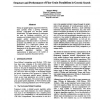Free Online Productivity Tools
i2Speak
i2Symbol
i2OCR
iTex2Img
iWeb2Print
iWeb2Shot
i2Type
iPdf2Split
iPdf2Merge
i2Bopomofo
i2Arabic
i2Style
i2Image
i2PDF
iLatex2Rtf
Sci2ools
ICGA
1993
1993
Structure and Performance of Fine-Grain Parallelism in Genetic Search
Within the parallel genetic algorithm framework, there currently exists a growing dichotomy between coarse-pain and fine-grain parallel architectures. This paper attempts to characterize the need for fine-grain parallelism. and to introduce and comparethree modelsof fine-grain parallel genetic algorithms (GAS). The performance of the three models is examined on seventeen test problems and is compared to the performance of a coarse-grain parailel GA. Preliminary results indicate that the massive distribution of the fine-grain parallel GA and the modified population topology yield improvements in speed and in the number of evaluations required to find global optima.
Fine-grain Parallel | Fine-grain Parallel Architectures | ICGA 1993 | ICGA 1997 | Parallel Genetic Algorithms |
| Added | 02 Nov 2010 |
| Updated | 02 Nov 2010 |
| Type | Conference |
| Year | 1993 |
| Where | ICGA |
| Authors | Shumeet Baluja |
Comments (0)

